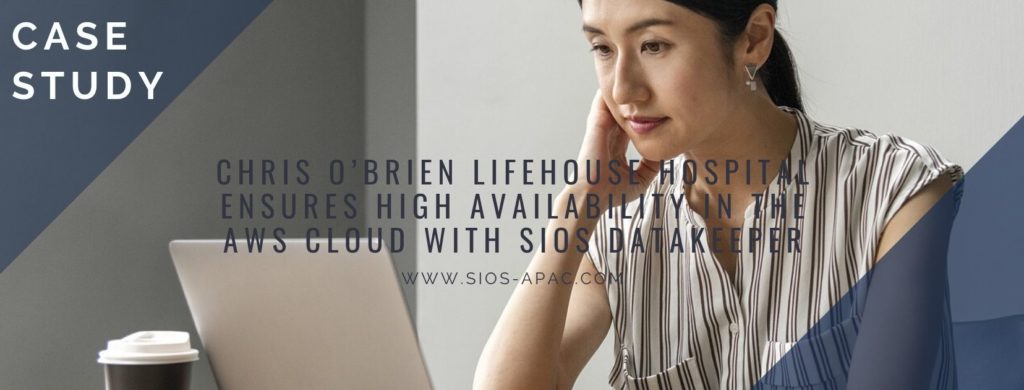Case Study: Chris O’Brien Lifehouse Hospital Ensures High Availability in the AWS Cloud with SIOS DataKeeper
SIOS Chosen for its Ability to Deliver both High Availability and High Performance
 Chris O’Brien Lifehouse (www.mylifehouse.org.au) is an integrated and focused center of excellence specializing in state-of-the-art treatment and research for patients who are suffering from rare and complex cancer cases. Lifehouse offers everything a cancer patient might need in one place, including advanced oncology-surgery, chemotherapy, radiation therapy, clinical trials, research, education, complementary therapies and psychosocial support. Situated alongside Royal Prince Alfred Hospital and the University of Sydney in Camperdown, the not-for-profit hospital sees more than 40,000 patients annually for screening, diagnosis and treatment. As one of Australia’s largest clinical trial centers, Lifehouse also provides its patients access to the world’s latest cancer treatment breakthroughs.
Chris O’Brien Lifehouse (www.mylifehouse.org.au) is an integrated and focused center of excellence specializing in state-of-the-art treatment and research for patients who are suffering from rare and complex cancer cases. Lifehouse offers everything a cancer patient might need in one place, including advanced oncology-surgery, chemotherapy, radiation therapy, clinical trials, research, education, complementary therapies and psychosocial support. Situated alongside Royal Prince Alfred Hospital and the University of Sydney in Camperdown, the not-for-profit hospital sees more than 40,000 patients annually for screening, diagnosis and treatment. As one of Australia’s largest clinical trial centers, Lifehouse also provides its patients access to the world’s latest cancer treatment breakthroughs.
The Environment
Lifehouse uses the MEDITECH healthcare Electronic Medical Record and patient administration system, which stores the electronic health records for all patients in a database.
“The health information system and database are vital to the care we provide, and if either goes down, patient records would not be accessible, and that would paralyze the hospital’s operations,” explains Peter Singer, Director Information Technology at Lifehouse.
In the hospital’s datacenter, mission-critical uptime has been provided by Windows Server Failover Clustering (WSFC) running on a Storage Area Network (SAN). But like many organizations, Lifehouse wanted to migrate to the cloud to take advantage of its superior agility and affordability.
The Challenge
Lifehouse chose Amazon Web Services as its cloud service provider, and had hoped to “lift and shift” its environment directly to the AWS cloud. To simulate its on-premises configuration, Peter chose a “cloud volumes” service available in the AWS Marketplace. Failover clusters were configured using software defined storage volumes to share data between active and standby instances, and testing proved that the approach could provide the automatic failover needed to satisfy the hospital’s demanding recovery point and recovery time objectives.
There was a problem, however: The use of software-defined cloud volumes had a substantial adverse impact on throughput performance. With so many elements and layers involved, performance problems are notoriously difficult to troubleshoot in software defined configurations deployed in the cloud. With the “No Protection” option specified, the cloud volumes performed well. But “No Protection” was not really an option for the Chris O’Brien Lifehouse Ensures High Availability in the AWS Cloud with SIOS DataKeeper
“We were able to go from testing to production in a matter of days. Ongoing maintenance is also quite simple, which we expect will minimize our operational expenditures associated with high availability and disaster recovery,” said Peter who is responsible for mission-critical MEDITECH application and its database. “We made every reasonable effort to find and fix the root cause, and eventually concluded that software-defined storage would never be able to deliver the throughput performance we needed,” Peter recalls. So the team at Lifehouse began looking for another solution.
The Evaluation
In its search for another solution capable of providing both high availability and high performance, Lifehouse established three criteria:
- Validation for use in the AWS cloud
- Ability to work across multiple Availability Zones
- Performance that was as good as or better than what had been achieved on-premises
- Security / Privacy with support for encryption in motion and at rest
Validation was important to minimize risk associated with using a third-party solution in the cloud. The ability to work across multiple Availability Zones would assure business continuity in the event an entire AWS datacenter was impacted by a localized disaster. The sub-millisecond latency AWS delivers between Availability Zones would be critical to being able to replicate data synchronously to “hot” standby instances to meet the hospital’s demanding recovery time and recovery point objectives.
After conducting an exhaustive search, Peter concluded that the best available solution was SIOS DataKeeper Cluster Edition from SIOS Technology. SIOS DataKeeper was available on the AWS Marketplace, which assured it was proven to operate reliably in the AWS cloud. And because it did not use software-defined storage, Peter was confident SIOS DataKeeper would be able to deliver the performance Lifehouse needed.
The Solution
SIOS DataKeeper provides the high-performance, synchronous data replication Lifehouse needs. By using real-time, block-level data mirroring between the local storage attached to all active and standby instances, the solution overcomes the problems caused by the lack of a SAN in the cloud, including the poor performance that often plagues software-defined storage. The resulting SANless cluster is compatible with Windows Server Failover Clustering, provides continuous monitoring for detecting failures at the application and database levels, and offers configurable policies for failover and failback.
Lifehouse currently has eight instances in SANless failover clusters to support its MEDITECH application and database across different AWS availability zones to protect against widespread disasters. The latency inherent across the long distances involved normally requires the use of asynchronous data replication to avoid delaying commits to the active instance of the database. But the real-time, block level data mirroring technology used in SIOS DataKeeper still enables Peter Singer to achieve a near-zero recovery point.
The Results
Unlike software-defined shared storage, SIOS DataKeeper is purpose-built for high performance high availability, so it came as no surprise to Peter Singer that the cloudbased configuration now works as needed. What was a bit surprising was just how easy the solution has been to implement and operate: “We were able to go from testing to production in a matter of days. Ongoing maintenance is also quite simple, which we expect will minimize our operational expenditures associated with high availability and disaster recovery.”
SIOS DataKeeper has enabled Lifehouse to take full advantage of the economies of scale afforded in the cloud without sacrificing uptime or performance. “If it were not for SIOS, we might not have been able to migrate our environment to the cloud,” Peter Singer concluded.


 SIOS DataKeeper was determined to be the only way to ensure a simple, manageable and yet cost-effective and robust solution that supported multiple integrations of devices and data securely, while also guaranteeing a high availability outcome.
SIOS DataKeeper was determined to be the only way to ensure a simple, manageable and yet cost-effective and robust solution that supported multiple integrations of devices and data securely, while also guaranteeing a high availability outcome.